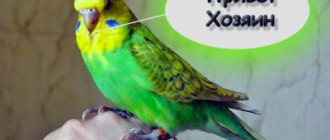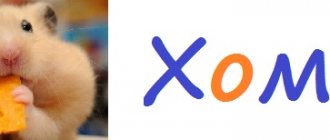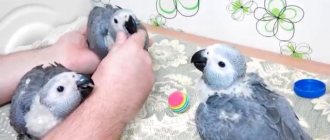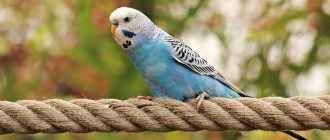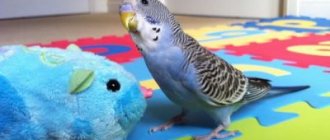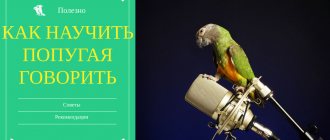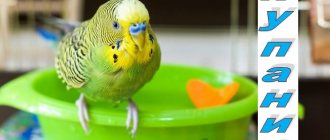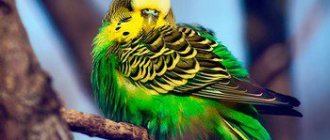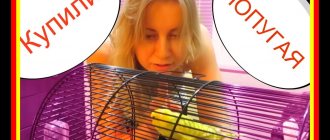In the wild, budgies regularly take water treatments and diligently monitor their hygiene. They bathe in tropical rains, during watering, or in the morning dew. Exotic birds have genetically passed on such cleanliness to their domestic counterparts.
Budgerigars, bred through selective breeding, are more pampered and vulnerable than their wild relatives. They have successfully adapted to the home climate, but they need to receive regular human care and attention. How often should you bathe budgies, and how to do it correctly.
Is it possible to bathe a parrot and why is it necessary?
You can and should bathe your budgie. Ornithologists say that water procedures are necessary for the health and beauty of birds. Every day, parrots clean their feathers on their own using their beaks, but such “dry” cleaning is not enough. Bathing allows you to solve the following vital issues:
- moisturizing the skin and plumage of birds, which is especially valuable in dry air at home;
- cleansing the body and feathers of room dust and various contaminants that inevitably occur due to the curious nature of parrots;
- prevention and disposal of possible fungal diseases and ectoparasites (insects living on the upper layers of the skin);
- improvement of the condition of birds during the period of active molting - when the itching intensifies, water brings relief;
- protecting the body from overheating in the hot months of summer or in a heated room in winter.
In addition to the benefits for the physiology of parrots, bathing has a beneficial effect on their psychological health. Birds usually enjoy water treatments and willingly splash or play in the water. Often bathing helps speed up the establishment of mutual contact; the parrot begins to trust its owner more.
The natural environment of budgerigars is the tropics, where there is high humidity. Therefore, pets do not like heat and need regular contact with water.
How many days to expect chicks?
As soon as the first eggs are laid, the female should immediately begin to hatch them. The male does not take part in this; his role is to bring food closer to his partner. The bird turns the eggs to ensure even heating. Sometimes it leaves the nest to drink and empty its bowels. In a few minutes, the eggs do not have time to cool down; a slight drop in temperature does not harm the embryos.
The normal hatching time for chicks is 18 days. After the time allotted by nature has passed, the chick breaks the shell from the inside with its beak and gets out. The female helps the cub to free itself and sometimes eats the shell. To prevent the newborn from sticking its skin to the shell, you need to maintain the air humidity in the room at 60%.
After the first baby hatches, remove soaked grains from the new mother’s diet.
Remove the empty shells from the house with care, but do not touch the babies. Having sensed a foreign smell on the chicks, the bird may abandon them or show aggression
Bathing rules
There is no single algorithm of actions. How often it is necessary to bathe a parrot depends on the time of year, individual living conditions, health and character of the bird. In order for the bathing process to be beneficial, the following rules must be observed:
- In winter, it is enough to bathe a parrot 2-3 times a month . After washing, take the bird on a towel under a table lamp - it emits soft warmth, and the pet will dry comfortably. You can first gently blot it or wrap it in terry cloth if the bird is tame and likes close contact. It is strictly forbidden to actively wipe the body, dry it with a hairdryer or bring it to a fan heater.
- In summer, parrots can bathe daily . If the bird is water-loving, then in extreme heat it is capable of refreshing itself even 2 times a day on its own, without waiting for an invitation from the owner. In such cases, it is important to monitor the purity of the water and change it after each bath. Another type of parrot considers washing an annoying necessity and does it with obvious reluctance. For them, it is enough to carry out the procedure 2 times a week (every other day in hot weather). Drying is not necessary in summer; the bird shakes itself off and dries quickly in the air.
- During the off-season, the frequency of bathing depends on the room temperature . Optimal values are +20-23°C. If the house is cooler, it is enough to wash the bird once every 7-10 days. When the apartment is very hot, you can bathe the parrots 1-2 times a week. You need to turn on the drying lamp and watch the bird - whether it will dry under it or on its own. In the future, act according to the pet’s wishes.
An important condition is the physical and psychological state of the bird. Water treatments are only useful for healthy parrots. If your pet is sick, bathing should be postponed until complete recovery.
It is also not recommended to wash when the bird is “out of sorts.” Parrots are living creatures. They experience periods of decreased activity and mood swings. On such days, you should not insist on water games; it is better to wait for the moment when the bird perks up and is cheerful.
Budgerigars should not be force-bathed. Decorative individuals are very sensitive and vulnerable. Any coercion can not only discourage the desire for water, but also push the bird away from the owner forever.
Preparing for a swim
When the parrot has adapted to its home and close contact with the owner has been established, it is time to prepare for water procedures. Bathing should be beneficial and enjoyable for the bird. Therefore, it is important to properly prepare for the process and follow certain instructions:
- the air temperature in the room should not be lower than +19°C;
- make sure that there are no drafts - close the windows, balconies and doors, otherwise the bird may catch a cold;
- in hot weather, turn off air conditioners and fans;
- in summer the water should be at room temperature, in winter warm (you cannot bathe the parrot in hot or cold water);
- use drinking water or filtered running water for a bath (parrots often drink it while bathing);
- choose a shallow and wide container - the side height of up to 5 cm eliminates the risk of accidental drowning, and the spacious area allows the bird to splash freely with its wings spread;
- pour water to a height of 2-3 cm - this depth is optimal for comfortable swimming;
- create twilight in the room - parrots do not like bright light, they feel unprotected in it and begin to behave restlessly.
It is better to bathe in plain water, without any detergents. They should be used in extreme cases, when the bird has stained its feathers with chemicals and can become poisoned (glue, varnish, paint, household chemicals). Then you need to use a special shampoo for birds or a fragrance-free baby wash. Finally, rinse the feathers thoroughly with clean water.
If it is not possible to wash off the stains with shampoo, the contaminated plumage should be carefully cut off. Otherwise, when cleaning feathers, the parrot may get poisoned.
How to bathe a parrot correctly
The optimal time for the procedure is morning until noon. In the wild, budgerigars fly to the water at dawn, so their domestic counterparts are active at these hours. Often the birds themselves give a signal of readiness - they fluff their wings, play with the drinker and splash water.
One of the most common methods is to bathe in a special bird bath. The step-by-step procedure looks like this:
- Clear the table (or other surface) of foreign objects because there will be a lot of splashes.
- Prepare a towel for drying, if necessary, turn on the lamp in advance and place a soft bedding under it.
- Pour warm, clean water into the container to a depth of 2-3 cm (taking into account the age and size of the pet). If the bird likes to play during the process, place a mirror next to the bathtub and put 1-2 toys in the water.
- Carefully take the parrot in your hand so that you hold the head higher than the cheeks with your thumb and forefinger, and use the rest to support the body.
- Place the bird in the bath and, holding it with one hand, gently rinse it with the other, wetting and smoothing the feathers in the direction of growth (from crown to tail). 2-4 ablutions are enough.
- Allow the bird to shake itself off, then lightly blot it with a towel and place it under a lamp.
If your parrot likes to bathe, after washing, you can leave him in the bath to splash around until he has had enough of playing. After each wash, the water must be removed immediately so that the bird does not drink dirty water. At the end of the procedure, it is important to praise the pet and treat it to its favorite dish. This is how the bird retains the information in its memory that bathing is a pleasure.
When can a bird be released from its cage?
On average, a parrot needs about 2-3 weeks to adapt. During this time, he gets used to the environment and interior items. The latter also act as landmarks during flight. If the bird is released early during a period of stress, it can cause serious injury to itself.
In the best case, the pet will get stuck somewhere in a hard-to-reach place, and in the worst case, it will damage its wings or paws. Moreover, the bird will most likely completely refuse to return to the cage, and catching it will aggravate the stressful condition.
Birds are less excited in the afternoon. Therefore, it is better to release them from the cage in the late afternoon. At the same time, it is necessary to monitor the first flights of the parrot, and, if necessary, help him.
Before releasing the bird, you need to prepare the room:
- Close all the windows and doors, and cover the windows with daytime curtains.
- Clear the room of dangerous objects.
- Move the plants to another room.
- Block access to closets and other places where the bird can hide.
- Remove decorative decorations suspended on threads: airplanes, balls, toys, etc.
Budgerigars will test all interior items for strength, so valuable things, such as household appliances or expensive sets, should also be moved to another room.
other methods
There are more than 200 species of domestic budgerigars (unlike wild ones, of which there is one family). They differ not only in color and feather shape. Each bird has its own character and habits. Therefore, the parrot himself often makes it clear how he likes to swim. After experiments and observations, the owner can only accept his choice.
In addition to the traditional bath, there are a number of other ways to keep your pet clean.
Under running water
This is the easiest way to wash your parrot. It is used when the bird has perfectly adapted to the house and loves to accompany its owner in everything. If your pet is brave and curious, he will quickly master bathing under running tap water. This type of washing has a number of rules that must be followed:
- the water must be free of chlorine, a filter must be installed on the tap;
- first you need to set up warm water, then invite the bird to swim;
- keep the pressure low, the stream should be thin;
- do not hold the parrot under a stream of water; the bird itself sprays water and washes itself in the drops (or waits until the owner sprays the water).
A method that is effective is when the owner holds his hands under the stream and cups it in his palms. Tame parrots willingly bathe in such an improvised “pool”.
Bath with greenery
In nature, wild birds often bathe in dense grasses covered with dew. That’s why many pets love to take a bath with herbs. Options for such a bath can be different:
- Line the bottom of the container with lettuce leaves and pour water on top. The bird may peck the grass while washing.
- In the parrot’s usual bath, scatter several shoots of plants that he loves (use only fresh herbs).
- Make a bath only from grass. Place a thick layer of young greens in a suitable container, generously soaked in water. This method is especially good for parrots that dislike water or are shy.
It is important to know that not every herb is good for birds. There are harmful and poisonous types of greens that are contraindicated for parrots. List of plants that can be used:
- plantain;
- dandelion;
- carrot and beet tops;
- spinach;
- clover;
- nettle (previously scalded with boiling water);
- woodlice;
- wheat and barley sprouts.
These herbs can not only be added to the bath, but also introduced into the diet of pet parrots.
From time to time, it is useful for parrots to take baths from a weak decoction of chamomile or horsetail (you can alternate). They enrich the bird’s body with vitamins, improve digestion and have an anti-inflammatory effect.
Using a spray bottle
This method is often suitable for birds that refuse to approach a water bath. You need to choose a coarse spray model so that the water drops serve as artificial rain for the parrot. The washing rules are as follows:
- the water should be warmer than in a bathhouse, since when splashed, the drops cool quickly (optimal temperature +25°C);
- hold the shower above the bird’s head at a distance of 25-30 cm, creating the illusion of rain;
- do not apply too much pressure so that the water flows gently onto the body and does not frighten the parrot;
- If the bird washes itself in a cage, first remove food and excess toys (to allow room for wings to flap).
Bathing time in the shower is 5-7 minutes. If the parrot is keen on the procedure, you can extend it to 15 minutes.
In the purified sand
For such a bath you need to use special fortified sand. Regular river or sea will not work. The larvae of various insects and parasites that can harm the bird often “live” in it.
A layer of sand 1.5-2 cm high should be poured onto the bottom of a small container. The parrot climbs into it and cleans the skin and feathers there. Usually a sand bath is used in 2 cases:
- When a bird is terribly afraid of water (shy by nature or the first experience has turned into a phobia).
- In winter, when the room is cold. In such a situation, it is better for the parrot to wash in the sand than to catch a cold after water procedures.
You can throw familiar toys into the sand to make the cleaning process interesting and fun for the bird.
In talc
If the parrot is very shy, it is cleaned with baby powder with a talc base. Apply a little product to the plumage and rub it in carefully. At the end of the procedure, the powder is not washed off; the bird itself will clean it out over time.
When using “dry” methods, you should not give up trying to accustom your parrot to the bath. Carefully and delicately, you can instill healthy habits in your pet.
How to accustom a parrot to water procedures
In the first days after purchasing the parrot, you should not touch it. The bird needs to be given time to explore a new place, get used to the inhabitants of the house and its cage. The adaptation period usually lasts 2-4 weeks. The younger the parrot, the easier it is for him to get used to it.
When the pet begins to leave the cage without fear, goes into your arms and plays willingly, it’s time to accustom it to water. The easiest way is to take the parrot with you whenever it comes into contact with water. Place it on your shoulder when you need to wash dishes or take a bath. If the bird is trusting and curious, soon it will splash in the owner’s palms, take a shower or wash itself under the running tap.
For wary and timid parrots, there are other methods:
- Bath suspended in a cage . To attract attention, you need to put a mirror, a favorite toy or treat (you can do all of them at once) at the bottom of the bathtub. The pet will be tempted and jump inside. Repeat next time, but moisten the bottom and walls with water. When the parrot willingly jumps into the bath, you can pour water.
- Bath outside the cage . Freedom-loving parrots, which fly into the cage only to feed and sleep, prefer to swim “in the wild.” For them, the bath must be placed on a table (or other surface). Place a toy inside, pour a little water on the bottom, and place a mirror next to it. The parrot will become interested and fly up to reconnoiter the situation. You can’t rush things - curiosity will still overcome the bird, and it will gradually stop being afraid. When this happens, you can add more water.
- A container of water under the stand . Parrots love to imitate natural conditions and enjoy spending time on areas with branches. You can make them yourself or purchase them from pet stores. A mirror and favorite toys are placed on the branches. The bath can be placed near the stand by moistening it with water or placing wet grass on the bottom. When the parrot begins to descend into it, the amount of water must be gradually increased.
With any method, the main condition is not to scold the pet or force it. Parrots are vulnerable and touchy; a sudden movement or loud sound can be stressful for the bird. It is better to be patient, and natural curiosity and trust in the owner will do their job. Be sure to reward every success - praise your pet and give your favorite treats.
The optimal age for purchasing parrots is chicks up to 2 months old. Young birds are more open to communication, friendly and trusting. Adult individuals often already have negative experiences from previous owners; it is more difficult for them to learn and establish new contacts. You need to be especially patient with them.
Cage care
Clean the cage at least twice every week. To do this, use warm water. It should not contain any substances that you usually use in everyday life for cleaning or cleaning anything. That is, do not use powders, floor liquids, etc. to care for your parrot’s home. Make sure you have a cleaning brush. For example, an unnecessary, used toothbrush is perfect for these purposes.
After you wash all the things that are in the cage, do not forget to wipe them with a dry cloth. The dirtiest part of a bird's home is the tray. Therefore, clean and wipe it thoroughly. When the cleaning is completed, you can place new paper on the bottom of the clean cage or sprinkle special sand purchased at the pet store.
What can be used as a bath
Special baths can be open or closed (with a transparent dome that retains splashes). They produce models with a fountain or shower included. If there is no such bath or the parrot flatly refuses to wash in it, it is easy to find a replacement from household utensils.
Any wide container with low sides is suitable for a bath - a deep plate, a saucer, a small plastic container. It is important that the pet is comfortable. And if the parrot ignores a luxurious bath and willingly splashes around in a nondescript plate, you should allow him to bathe where he likes.
Recommendations
To ensure that bathing brings only benefits and does not harm the bird, it is important to consider the following factors:
- when the parrot diligently cleans its feathers and begins to actively scratch itself, it’s time to take a bath;
- if water or shampoo gets into the nostrils, carefully turn the bird upside down and hold for 5-7 seconds;
- You cannot force a bath, but if your pet is soiled with chemicals that are dangerous to its life, it must be immediately washed with shampoo;
- It is forbidden to rub and stroke against the plumage - this is harmful to the skin and can cause stress in the bird;
- Remember that the parrot chooses the method of bathing, and a caring owner respects the pet’s choice.
Skin cells have a protective layer, so frequent bathing and lack of water procedures are equally harmful for the bird. In hot weather, the parrot may suffer from overheating, which means it will strive for water every day. In winter, on the contrary, even water-loving birds noticeably cool down to swimming.
Budgerigars live by instinct, and their behavior will always tell you when it’s time for them to take a bath. A bird that receives attention and care is always healthy, sociable and cheerful. And bathing becomes not only a necessary part of hygiene for parrots, but also another way to have fun and play with the owner.
Useful tips
When taming a pet, do not wave your hands over its head. This is due to the fact that they have a reflex that a flicker from above is the shadow of a bird of prey. As a result, an association will arise: hand – danger. It will be impossible to retrain the bird.
https://youtube.com/watch?v=xBMTWd9uTYg
https://youtube.com/watch?v=xBMTWd9uTYg
Training is a rather lengthy process. Some wavy animals become tamed only at one year of age. You cannot punish a bird if it bites. This is an adequate reaction to an invasion of personal space. Or the pet is defending itself. In such a situation, try to calm the parrot in an even voice or move away from him. After some time, the procedure can be repeated.
You should not lure the bird with treats when it is just starting to leave its cage. In addition, you should not grab it suddenly. The purpose of taming is to make the pet not afraid of your palms. If you do everything right, you can quickly win the love and trust of your feathered friend.
